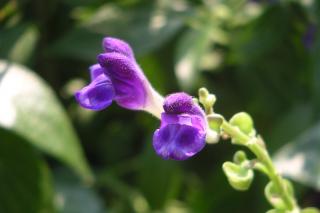

Native to North America, blue skullcap or mad-dog skullcap is a herbaceous plant of the mint family that, if well exposed to sunlight, will grow very well in moist and rich soil – storing nutrients and compounds that share excellent health benefits.
With over three hundred species that grow in tropical and temperate climates of South-East Asia, Europe and North America, blue skullcap or North American skullcap was known for its medicinal uses.
As time passed, it was slowly forgotten as opium-derived substances and synthetic compounds replaced some of its medicinal uses.
However, today in Europe, this perennial plant is undergoing renewed scrutiny and is grown today by quite a few herbalists.
What are its health benefits? How should it be used well? What is there to know about this plant that can help fight off restlessness?
Belonging to the Lamiaceae family, blue skullcap (with scientific name Scutellaria lateriflora) was used by Native American Indians as a sedative, a soothing agent and also as a nervous tonic.
Towards the end of the 18th century, American herbalists used this plant as a basis for remedies that aimed to:
– soothe bouts of hysteria,
– increase the quality of sleep,
– treat rabies,
– lessen neurological disorders,
– and even treat epileptic convulsions.
Moreover, use of side-blooming skullcap was prescribed to treat functional disorders of the nervous system (for both adults and children), and also to appease neuralgic pain.

Most often, aerial parts of North-American skullcap plants aged 2 or 3 years old are used therapeutically.
Main active compounds are ascorbic acid, tannin compounds, flavonoids (scutellarein, scutellarin, baicalin, bicalein) and polysaccharids. This plant is used to lessen nervous tics, premenstrual syndrome symptoms, insomnia, muscle and motor tics, and especially restlessness.
The properties to remember for blue skullcap are:
– neuroprotective. It slows and stops development of certain disorders, among which are depression, Parkinson’s disease and Alzheimer’s.
– anxiolytic
– and finally muscle relaxant.
Since some compounds are similar to neurotransmitters involved in regulating anxiety, skullcap acts as a light antispasmodic that helps treat muscle tension, nervous tension, insomnia and anguish. It is increasingly prescribed by modern herbalists.
This perennial plant can be found in the wild. It’s also readily available on the market under various forms:
– in capsule form – It’s recommended to ingest capsules with an 850 mg rating prepared from stems, leaves and fruits twice a day. An alternative is to take those rated 850 to 1275mg from leaf materials only, 3 times a day.
If in doubt, refer to the manufacturer’s instructions.
– as an infusion – Bring 8 fluid ounces (25 cl) water to boiling. Add 1 table spoon dried leaves (with or without stem, flowers or fruits). Steep and then filter carefully.
Let it cool off before drinking. As for the dosage, once to thrice a day is prescribed.
– as a tincture – one dose of 0.06 fl. oz. (4 ml) 1 to 3 times a day is enough. Some experts advise to prepare and ingest alcoholic skullcap tinctures from fresh plants, so as to better retain its therapeutic properties. These are diminished after the drying process.
Skullcap may induce drowsiness. It’s thus recommended to use caution if you’re taking remedies against anxiety and insomnia.
Experts admit that severe cases of toxic hepatitis have occurred due to adulterated skullcap products. Indeed, this plant is sometimes confused and replaced with wall germander (Teucrium chamaedrys), which is a plant that looks very similar but is dangerous for health.
So adulterated skullcap is poisonous for the liver when it isn’t the pure product. If you’re purchasing some, best trust your supplier well!
If very high doses are taken, this plant could trigger convulsions, confusion, involuntary muscle contractions and even stupor.
This plant may be combined with other plants like passion flower, hops and either valerian or devil’s beard.
Ingesting “skullcap plant” is strongly discouraged for pregnant women and those who are breast feeding their child.